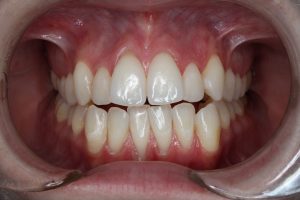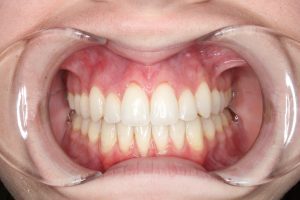
Braces or Invisalign: Customizing Care for Each Patient
By Dr. Emily Watson
Sometimes people feel self-conscious when they wear braces, hesitant to smile broadly.
So, when Invisalign came on the scene a little over two decades ago, those patients had a new option that came with a couple of advantages. One was that the patient didn’t need to go to the orthodontist’s office regularly to have the metal braces adjusted as the teeth gradually moved toward their desired position. Instead, with Invisalign, the patient is given a set of trays and, every week or two, they remove one tray and put in the next.
Another advantage: Those aligners aren’t as noticeable as braces, allowing people to smile away without announcing to the world that they were trying to straighten their teeth.
Many orthodontists weren’t quick to adopt Invisalign when it first went on the market in the late 1990s, but over time that changed and the product has gained acceptance. Since its inception, Invisalign has reportedly helped more than 234,000 orthodontists treat more than 14.5 million patients around the world. That’s a lot of crowded teeth, overbites, underbites, and other unwanted teeth problems corrected.
Still, some orthodontists may be reluctant to use Invisalign for more complex cases, sticking with metal braces for situations such as extreme tooth crowding. But I’ve treated severe crowding cases with Invisalign and they can turn out nicely.
Of course, I was also helped by participating in a fellowship that provided an intensive dive into aligners. When you don’t have that kind of additional knowledge and training, it can seem overwhelming. It becomes one of those “you don’t know what you don’t know” situations. That extra knowledge adds to your confidence in both yourself and in the product.
Younger Kids and Invisalign
Although Invisalign is used more often for adults and teens, I have offered it to younger children as well with good results.
What I like about aligners for these younger patients is that their teeth move easier than adults, so they don’t have to wear the trays quite as long to get the desired results. They can just wear them after school and at night, and the job gets done. This is especially reassuring for parents who worry that a young child might take out the tray while at school and leave it somewhere, never to be seen again. That would hinder the progression because each tray needs to complete its tooth movement before the patient advances to the next tray.
Elementary age children can remove their tray in the morning, hop on the school bus, spend the day learning and spending time with friends, and then put the tray back in when they arrive home several hours later. Adults and teenagers are not able to do this and need to wear their trays for about 22 hours every day, removing them only to eat and drink.
Monitoring progress from afar
That takes care of parental worries about young children misplacing a tray or failing to wear it when they are out of sight of mom and dad. Teenagers are another matter, though, because as I mentioned, they need to wear the trays almost around the clock, just like adults.
Parents often worry that their teenagers will fail to wear the trays correctly, which is a legitimate concern. In the past, I’ve had problems with teenagers whose trays never seemed to fit correctly. The reason: They weren’t following the proper procedures.
Parents and orthodontists would exhaust themselves if they tried to keep track of every move those teenagers made. Fortunately, technology is always evolving and helping both the parents and me solve that problem. We can now use a dental monitoring app that allows me to keep track of patients’ treatment so I know each week whether they aren’t properly wearing the tray and whether any adjustments need to be made.
Here in a nutshell is how that works: The patient has a scanbox they use to take photos of their teeth with and without their trays in. I can review the results and there is also artificial intelligence built into the software to assist in the check. Through this monitoring system, I can find out what’s happening with a patient’s smile without the need for them to come to the office. I can then give them guidance and instructions based on what I learn. This app allows us to give instructions to the patients to switch to their next tray once their teeth have completed the proper movement. If the patient hasn’t worn their trays ideally, or their teeth are taking longer to complete the movement, I am able to see what is going on and tell them to either stay in the tray or move forward. This app eliminates the frustration of having to move back trays when I see them in our office if the trays aren’t fitting correctly.
Patient Preferences and a Wedding Deadline
Invisalign hasn’t taken over completely. Some patients still prefer braces. Also, there may be specific instances where I feel braces are the better option to accomplish what needs to be done.
Philosophically, whether I am using Invisalign or braces, I like to make sure I am using forces that are light on the teeth. In the old days, they would put spacers between every tooth, and a band around every tooth. Everything was high intensity, forcing the teeth to move. Now we use forces that are more light and gentle.
With the braces we use, the wires are flexible, so we can bend them into the brackets the way we want. But those wires also are heat activated and have a memory. They want to return to their original shape, so as they sit in the patient’s mouth they try to return to the form they started with, and that’s how light pressure is put on the teeth and begins to straighten them.
With Invisalign you only move the teeth 0.1 to 0.2 millimeters per tray, so you are changing the tray every week or so to gently move the teeth. What the teeth are doing is assuming the shape of the tray. Once they have done that, it is time to move to the next tray. It’s a nice, delicate process.
With all patients, I customize their treatment depending on what they are trying to achieve and what they want, whether that means braces or Invisalign. Occasionally, I have even done a hybrid treatment, starting out with braces to get severe crowding taken care of, and then finishing with the aligners.
On occasion, though, a patient is adamant about their choice.
One patient came in with crowded teeth and a deadline. She was getting married in six months and wanted a new smile on her wedding day. Invisalign could have improved her smile greatly, but not in six months, so we went with braces.
Even then, the deadline was tight. For her wedding, I removed the braces long enough for her to get through the ceremony, the honeymoon, and the wedding photos.
After the nuptials, we finished the job with Invisalign.




